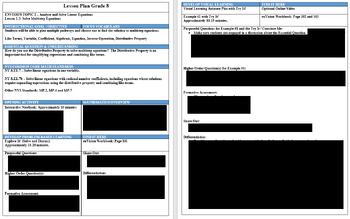8th Grade enVision Lesson 2-3: Solve Multistep Equations
- Word Document File
Also included in
- This bundle includes TEN LESSON PLANS. All lesson plans are EXTREMELY DETAILED and directly connects to the enVision Math Curriculum for 8th grade. These are JUST THE LESSON PLAN DOCUMENTS, NOT the actual activities or assessment tools. The lessons included in this bundle are for TOPIC 2 - AnalyzPrice $71.93Original Price $89.91Save $17.98
- This BUNDLE includes 52 LESSON PLANS!This is for the ENTIRE 8th GRADE enVision CURRICULUM!All lesson plans are EXTREMELY DETAILED and directly connect to the enVision Math Curriculum for 8th grade. These are JUST THE LESSON PLAN DOCUMENTS, NOT the actual activities or assessment tools. The lessoPrice $467.53Original Price $519.48Save $51.95
Description
This is an EXTREMELY DETAILED lesson plan that directly connects to the enVision Math Curriculum for 8th grade. This lesson plan is 4 pages long and includes the following categories:
- enVision Topic
- Next Generation / Common Core Standards
- Instructional Goals
- Essential Question
- Vocabulary
- Supplementary Materials
- Develop Problem Based Learning - Solve & Discuss It
- Practice and Application Activities
- Scaffolds / Differentiation / Questioning
- Developing Visual Learning with Examples and Videos
- Practice and Application
-Item Skills Analysis
- Special Education Component
- English Language Learner Component
- SEL Component
- Review, Assessment, and Extension
- Teacher Lesson Reflection Questions
This is JUST THE LESSON PLAN DOCUMENT, NOT the actual activities or assessment tools.





